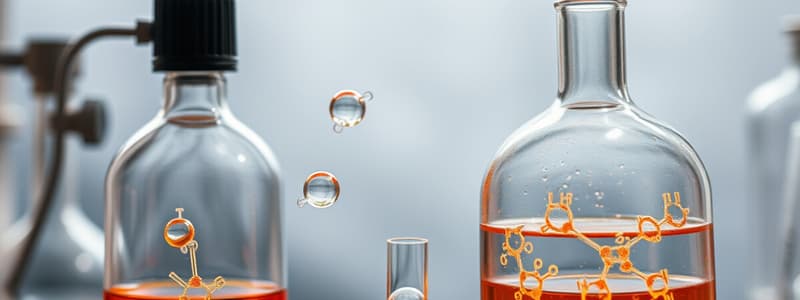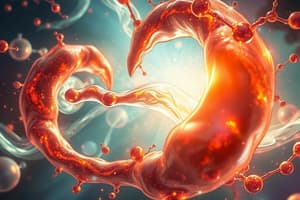Podcast
Questions and Answers
Which statement about solvolysis reactions is correct?
Which statement about solvolysis reactions is correct?
- Solvolysis reactions are a type of SN2 reaction.
- In solvolysis reactions, the solvent acts as the nucleophile. (correct)
- Solvolysis reactions primarily require strong nucleophiles.
- All solvolysis reactions result in stable carbocations.
What characteristic makes an electrophile ideal for SN2 reactions?
What characteristic makes an electrophile ideal for SN2 reactions?
- Presence of large atoms bonded to the carbon with the leaving group.
- The ability to form a stable tertiary carbocation.
- Involvement of weak nucleophiles in the reaction.
- Having small atoms bonded to carbon with the leaving group. (correct)
Which nucleophile is considered weak and is acceptable for SN1 reactions?
Which nucleophile is considered weak and is acceptable for SN1 reactions?
- Water (H2O) (correct)
- Ammonia (NH3)
- Hydrochloric acid (HCl)
- Sodium hydroxide (NaOH)
Which of the following statements is true regarding carbocations?
Which of the following statements is true regarding carbocations?
What is the trend in the strength of nucleophiles in relation to their position on the periodic table?
What is the trend in the strength of nucleophiles in relation to their position on the periodic table?
Which solvent type is preferred for SN2 reactions involving small nucleophiles?
Which solvent type is preferred for SN2 reactions involving small nucleophiles?
Which of the following statements regarding leaving groups is true?
Which of the following statements regarding leaving groups is true?
What is the major outcome of SN1 reactions concerning the configuration of the product?
What is the major outcome of SN1 reactions concerning the configuration of the product?
Which of the following solvents is a protic solvent that can be used in SN1 reactions?
Which of the following solvents is a protic solvent that can be used in SN1 reactions?
What facilitates the occurrence of carbocation intermediates?
What facilitates the occurrence of carbocation intermediates?
Which nucleophiles are more favorable in SN2 reactions?
Which nucleophiles are more favorable in SN2 reactions?
What is a key characteristic of SN2 reactions in relation to configuration?
What is a key characteristic of SN2 reactions in relation to configuration?
Which reaction mechanism typically uses polar protic solvents?
Which reaction mechanism typically uses polar protic solvents?
Which of the following solvents is NOT considered a polar aprotic solvent suitable for SN2 reactions?
Which of the following solvents is NOT considered a polar aprotic solvent suitable for SN2 reactions?
What characteristic of SP2 hybridized carbons makes them unreactive in SN1 and SN2 reactions?
What characteristic of SP2 hybridized carbons makes them unreactive in SN1 and SN2 reactions?
E2 reactions can be best described by which of the following statements?
E2 reactions can be best described by which of the following statements?
Which of the following bases is typically used in E2 reactions?
Which of the following bases is typically used in E2 reactions?
E1 reactions require which type of base for effective reaction progression?
E1 reactions require which type of base for effective reaction progression?
In an E1 reaction, which of the following occurs first?
In an E1 reaction, which of the following occurs first?
What type of order does an E2 reaction follow?
What type of order does an E2 reaction follow?
Which statement accurately describes the nature of E1 reactions?
Which statement accurately describes the nature of E1 reactions?
What is the rate-determining step in an E2 reaction?
What is the rate-determining step in an E2 reaction?
Which type of solvent is required to stabilize the carbocation in E1 reactions?
Which type of solvent is required to stabilize the carbocation in E1 reactions?
In terms of order of reaction, how does E2 compare to E1?
In terms of order of reaction, how does E2 compare to E1?
Which of the following best describes a leaving group?
Which of the following best describes a leaving group?
What type of reaction mechanism does E1 follow?
What type of reaction mechanism does E1 follow?
Which alkyl halides are more reactive in E1 and SN1 reactions?
Which alkyl halides are more reactive in E1 and SN1 reactions?
Which characteristic distinguishes a nucleophile from a base?
Which characteristic distinguishes a nucleophile from a base?
What is the relationship between polar aprotic solvents and E2 reactions?
What is the relationship between polar aprotic solvents and E2 reactions?
What occurs when bulky bases are used with tertiary halides in elimination reactions?
What occurs when bulky bases are used with tertiary halides in elimination reactions?
What is the role of the ethoxide ion in E2 reactions?
What is the role of the ethoxide ion in E2 reactions?
Which of the following is true regarding the solvent type used in E2 reactions?
Which of the following is true regarding the solvent type used in E2 reactions?
What is the expected product when a secondary halide undergoes elimination with a strong base?
What is the expected product when a secondary halide undergoes elimination with a strong base?
What determines the stereochemical requirement in E2 reactions?
What determines the stereochemical requirement in E2 reactions?
What product is termed as the major product according to Zaitsev's rule?
What product is termed as the major product according to Zaitsev's rule?
When reacting with a protic solvent, what is the favored reaction type for strong bases?
When reacting with a protic solvent, what is the favored reaction type for strong bases?
What occurs if there is an absence of anticoplanar hydrogen in the reaction?
What occurs if there is an absence of anticoplanar hydrogen in the reaction?
Flashcards are hidden until you start studying
Study Notes
Solvolysis Reactions
- Solvolysis reactions are a specific type of SN1 reaction where the solvent acts as the nucleophile.
Nucleophiles
- Strong nucleophiles, typically negatively charged, are essential for SN2 reactions; strength increases up and left in the periodic table.
- Nitrogen and phosphorus can be moderately strong nucleophiles without a negative charge.
- Weak nucleophiles, like water, are suitable for SN1 reactions.
Electrophiles
- Small atoms bonded to carbon with the leaving group enhance backside attack in SN2 reactions.
- Methyl halides are ideal electrophiles, primary halides react quickly, secondary halides react slowly, and tertiary halides do not participate in SN2.
- Stable carbocation formation is required for SN1 reactions; tertiary carbocations are more stable than secondary, while primary and methyl carbocations need resonance for stability.
Solvents
- Protic solvents (e.g., water, alcohols) are necessary for SN1 reactions; not preferred in SN2 except with large nucleophiles.
- Aprotic solvents (e.g., acetone, DMSO, THF) are unsuitable for SN1 but favored for SN2, especially with small nucleophiles.
Leaving Groups
- A good leaving group is crucial for both SN1 and SN2, with the effectiveness order being iodide > bromide > chloride.
Rearrangements
- Carbocation intermediates are involved in SN1 reactions, allowing rearrangements.
SN1 and SN2 Reactions Comparison
- SN1 reactions lack carbocation intermediates, resulting in racemization and do not involve inversion of configuration.
- SN2 reactions involve a carbocation intermediate, leading to inversion of configuration.
SP2 Hybridized Carbons
- SP2 hybridized carbons do not follow typical primary, secondary, or tertiary classifications and do not undergo SN1 or SN2 reactions.
- The presence of pi electrons in SP2 carbons repels nucleophiles, rendering them unreactive.
E2 and E1 Reactions
- E2 reactions are concerted (single-step) and second-order, requiring a strong base, typically with negatively charged oxygen.
- E1 reactions are stepwise (multiple steps) and first-order, needing a weak base, involving carbocation formation before deprotonation.
Key Concepts
- A base donates an electron pair, whereas a nucleophile donates an electron pair to form a new bond.
- Polar protic solvents can donate a proton, aiding carbocation stabilization; polar aprotic solvents cannot donate protons and are used in SN2 reactions.
Trends in E1 and SN1 Reactions
- Tertiary alkyl halides are more reactive than secondary or primary in E1 and SN1 processes.
- Polar protic solvents stabilize carbocation intermediates; exceptions arise with bulky bases causing flawed substitution.
Exceptions to Zaitsev's Rule
- Bulky bases like t-butoxide are excluded in some reactions; ethoxide ion suffices.
- Anticoplanar hydrogens allow for products per Zaitsev's rule; minor products include anti-Zaitsev (Hoffman) products.
Predicting Products
- Major products align with Zaitsev's rule; minor products are anti-Zaitsev.
- The ethoxide ion serves as a strong base and nucleophile, with a protic solvent favoring E2 processes over SN2.
Stereochemical Requirement
- E2 reactions necessitate an anticoplanar configuration of the leaving group and hydrogen to be removed.
Studying That Suits You
Use AI to generate personalized quizzes and flashcards to suit your learning preferences.


